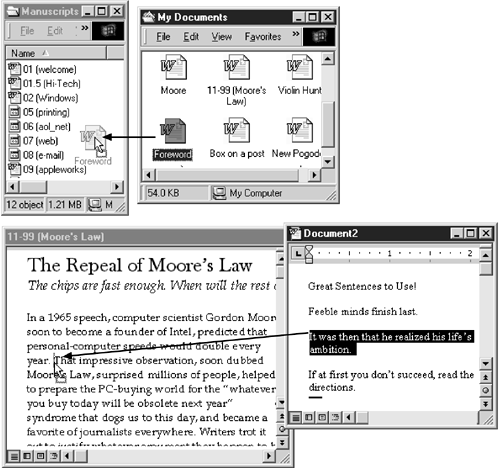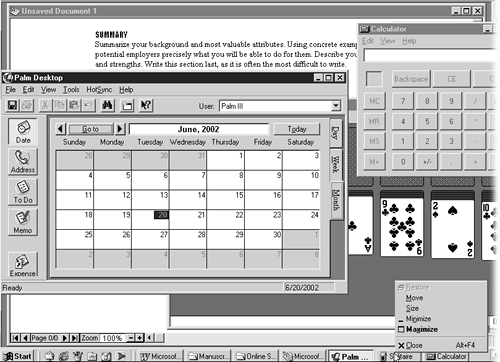Windows got its name from the rectangles on the screen—the windows—in which every computer activity takes place. You look at a Web page in a window, type short stories in a window, read email in a window, and look at the contents of a folder in a window—sometimes all at once.
This overlapping-windows scheme makes using a computer much easier than windowless operating systems like DOS. But it has a downside of its own, as any Windows veteran can tell you: As you create more files, stash them in more folders, and launch more programs, it's easy to wind up paralyzed before a screen awash with cluttered, overlapping rectangles.
Fortunately, Windows is crawling with icons, buttons, and other inventions to help you keep these windows under control.
There are two categories of windows in Windows: desktop windows (which open when you double-click a disk or folder icon) and application windows (which appear when you're working on a document or in a program, such as Word or Internet Explorer). Nonetheless, all of these windows have certain components in common. Figure 4-1 shows a representative example: the window that appears when you double-click the My Documents icon on your desktop.
Title bar. This top strip displays the name of the window. It's also the "handle" that you drag when you want to move the window on the screen.
Minimize button. Click this button to temporarily hide a window; it shrinks down into the form of a button on your Taskbar (see Section 4.3). (You can open it again by clicking that icon.) Keyboard shortcut: Press Alt+Space bar, then N.
Maximize button. Click this button to enlarge the window so that it fills the screen. (Keyboard shortcut: Press Alt+Space bar, then X.) At this point, the Maximize button turns into a Restore button (whose icon shows two overlapping rectangles), which you can click to return the window to its previous size.
Close button. Click the X to close the window. Keyboard shortcut: Press Alt+F4; or press Alt+Space bar, then C.
Menu bar. Click one of these words (such as File or Edit) to open a menu, which shows a list of commands available in this window.
Toolbar. Some windows have these special strips that hold one-click shortcut buttons, which are equivalents for menu commands Microsoft thinks you'll use frequently. (More on toolbars at the end of this chapter.)
Scroll bar. A scroll bar appears if the window isn't large enough to show all its contents, as described in the sidebar box on the next page.
Address bar. This bar lets you type in a Web address, or even the address of a folder on your PC; when you press Enter, that Web page or a list of the contents of the folder appears on the screen. (This bar shows up in desktop windows and Web browsers, not in application windows. See Section 11.3.1 for details.)
Control icon. The icon next to the title is actually a menu that offers commands for sizing, moving, and closing the window. You can double-click it to close a window; otherwise, it's not very useful, because its commands duplicate the other doodads described here.
Borders. You can change the size of a window by dragging these borders. Position your pointer over any border until the pointer turns into a double-headed arrow. Then drag inward or outward to reshape the window. (To resize a full-screen window, click the Restore button first.)
Explorer bar. This special left-side-of-the-window panel shows information about the window, or about whatever icon you click.
But using the View→Explorer Bar command, you can fill this half of the window with your choice of several other kinds of information: the Search pane described on Section 3.6, your list of Favorite icons and Web sites, the History list (folders you've opened recently), or Folders (the Windows Explorer-like folder tree described on Section 5.1.1). You can even choose Tip of the Day (to see a helpful Windows trick at the bottom of the window) or, if you're online, Discuss (to open a chat window).
Figure 4-1. All windows have the same basic ingredients, making it easy to become an expert in window manipulation. This figure shows a desktop window—a disk or folder; but you'll encounter the same elements in application windows.
It's easy enough to resize and reposition your desktop windows—an especially useful feature when more than one are open.
Every Windows window falls into one of these three categories:
Maximized means that the window fills the screen; its edges are glued to the boundaries of your monitor, and you can't see anything behind it. It gets that way when you click its Maximize button. This is a great condition for your window when you're surfing the Web or working on a document for hours at a stretch, because the largest possible window means the least possible scrolling.
Tip
When a window is maximized, you can restore it (as described below) by pressing Alt+Space bar, then R.
When you click a window's Minimize button (Figure 4-1), the window disappears from sight. It hasn't actually closed, however; it's simply reincarnated as a button on the Taskbar strip at the bottom of the screen. You can bring the window back by clicking this Taskbar button, which bears the window's name. Minimizing a window is a great tactic when you want to see what's in the window behind it.
A restored window is neither maximized nor minimized; it's a loose cannon, floating around on your screen as an independent rectangle. Because its edges aren't attached to the walls of your monitor like a maximized window, you can make it any size you like by dragging its borders.
Moving a window is easy—just drag the title bar.
Most of the time, you move a window to get it out of the way when you're trying to see what's behind it. However, moving windows around is also handy if you're moving or copying data between programs, or moving or copying files between drives or folders, as shown in Figure 4-2.
Figure 4-2. Creating two restored (free-floating) windows is a convenient preparation for copying information between them. Make both windows small and put them side-by-side, scroll if necessary, and then drag some high-lighted material from one into the other. This works either with icons in desktop windows (top) or text in applications like Microsoft Word (bottom). If you press Ctrl as you drag text in this way, you make a copy of the original passage instead of moving it.
You can close a window in any of several ways:
Click the Close button (the X in the upper-right corner of the window).
Click the icon in the upper-left corner, and then choose Close from the drop-down menu.
Press Alt+F4.
Right-click the window's Taskbar button (see Section 4.3), and then choose Close from the shortcut menu.
In application windows, choose File→Exit.
In desktop windows, choose File→Close.
When you close a document window in one of your programs, no matter which action you use, you're given an opportunity to save your work before the window closes. Be careful, too—in many programs, including Internet Explorer, closing the window also quits the program entirely.
Many people routinely keep four or five programs open at once—a calendar, word processor, Web browser, and email program, for example. Others (such as computer book authors) regularly work in just one program, but have several document windows open at once (representing several chapters, for example). Learning how to manage and navigate among a flurry of overlapping windows is an essential Windows survival skill.
When you have multiple windows open on your screen, only one window is active, which means that:
It's in the foreground, in front of all other windows.
It's the window that reacts to your keystrokes and mouse clicks.
The title bar of the active window is blue; the background (inactive) window title bars are gray. (You can change this color scheme, as described in Section 8.6.3.)
Just because a window is in the background, by the way, doesn't mean that it can't continue with whatever assignment you gave it. For example, when your word processor is printing a document, your email program may be collecting mail, or your Web browser can be loading a Web page. If a background program needs to pass a message up to you (such as an error message), it automatically pops to the foreground, becoming the active program. When you respond to the message (usually by clicking OK), Windows sends the program back to the background and returns you to the window you were using before the message appeared.
The Taskbar (Figure 4-3) can be a helpful assistant when you're working with multiple windows. It provides one-click window-manipulation commands. As you can see in Figure 4-3, it's not always easy to find a particular window.
To bring a window to the foreground, making it the active window, click its button on the Taskbar.
To minimize, maximize, restore, or close a window, even if you can't see it on the screen, right-click its button on the Taskbar and choose the appropriate command from the shortcut menu (Figure 4-3, bottom).
To arrange all open windows in an overlapping pattern (except those you've minimized), as shown in Figure 4-4, right-click a blank spot on the Taskbar and choose Cascade Windows from the shortcut menu.
Figure 4-4. Cascading windows are neatly arranged so you can see the title bar for each window. Click any title bar to bring that window to the foreground as the active window. After you've clicked a few title bars and worked in several windows, you'll have to choose the Cascade Windows command again to rearrange all your open windows.
To arrange all nonminimized windows in neat little boxes, each getting an equal rectangular chunk of your screen, right-click a blank spot on the Taskbar and choose Tile Vertically or Tile Horizontally from the shortcut menu.
To minimize all the windows in one fell swoop, right-click a blank spot on the Taskbar and choose Minimize All Windows from the shortcut menu.
If you change your mind, the Taskbar shortcut menu always includes an Undo command for the last Taskbar command you invoked. (Its wording changes to reflect your most recent action—Undo Minimize All, for example.)
Figure 4-3. There's a word processor buried in this morass, and without the Taskbar buttons at the bottom edge, it would take a lot of blind clicks to find it and make it the active window. Sometimes you need to bring a particular window into the foreground in a big hurry, especially if the boss arrives when you're playing Solitaire.
Tip
There's no command or keystroke to close all windows at once.
There is, however, a trick to closing multiple desktop windows: While pressing the Shift key, click the X in the upper-right corner of the last window you opened. Doing so doesn't close all open desktop windows, but it closes all the ones that sprang from a single "parent" disk or folder. For example, if you opened My Computer, then your C: drive, then your Program Files folder, the Shift trick closes all those windows. But if you had also opened the My Documents folder on the desktop, it stays open, because it wasn't part of the My Computer→C: drive→Program Files series.




